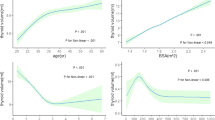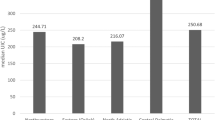Abstract
Iodine deficiency is recognised as a major preventable public-health worldwide problem. The aim of this study is to assess local reference values for thyroid volume, and give a snapshot of the epidemiology of goiter and iodine nutritional status of the Turin schoolchild population. Sonographic thyroid volume and median urinary iodine excretion were obtained in 1067 schoolchildren aged 11–15 yr resident in Turin for more than 5 yr to assess both goiter prevalence and iodine intake. All the subjects were asked to fill in a questionnaire about their life habits. Anamnestic and anthropometric data, thyroid volume by both bimanual palpation and ultrasonography were assessed, and spot urinary iodine samples were collected. The results show that the median urinary iodine concentration is 113.1 μg/l and the prevalence of goiter <5%, indicating this area as iodine-sufficient. Nevertheless, 40.5% of the schoolchild population has urinary iodine levels lower than the cut-off level recommended as iodine-sufficiency. Interestingly, the high relative prevalence of ultrasound features of autoimmune thyroid disease suggests autoimmune-thyroiditis as a frequent thyroid disease in Turin schoolchildren. As no active programs of salt, milk or water iodisation have ever been carried out, a silent iodine prophylaxis has probably occurred in the city. Despite a sufficient median urinary iodine excretion, a focused program of iodine prophylaxis should be developed due to the presence of a large rate of iodine-deficient population.
Similar content being viewed by others
References
WHO, UNICEF and ICCIDD. Assessment of iodine deficiency disorders and monitoring their elimination. A guide for programme managers. WHO/NHD/01.1. 2nd ed. Geneva: WHO, 2001.
Vermiglio F, Sidoti M, Finocchiaro MD, et al. Defective neuromotor and cognitive ability in iodine-deficient schoolchildren of an endemic goiter region in Sicily. J Clin Endocrinol Metab 1990, 70: 379–84.
Fenzi GF, Giusti LF, Aghini-Lombardi F, et al. Neuropsychological assessment in schoolchildren from an area of moderate iodine deficiency. J Endocrinol Invest 1990, 13: 427–31.
Aghini-Lombardi F, Antonangeli L, Martino E, et al. The spectrum of thyroid disorders in an iodine-deficient community: the Pescopagano survey. J Clin Endocrinol Metab 1999, 84: 561–6.
WHO, UNICEF and ICCIDD. Indicators for assessing iodine deficiency disorders and their control through salt iodization. WHO/NUT/94.6. Geneva: WHO, 1994.
WHO and ICCIDD. Recommended normative values for thyroid volume in children aged 6–15 years. Bulletin WHO 1997, 75: 95–7.
Vitti P, Martino E, Aghini-Lombardi F, et al. Thyroid volume measurement by ultrasound in children as a tool for the assessment of mild iodine deficiency. J Clin Endocrinol Metab 1994, 79: 600–3.
Foo LC, Zulfiqar A, Nafikudin M, Fadzil MT, Asmah ASA. Local versus WHO/International Council for Control of Iodine Deficiency Disorders-recommended thyroid volume reference in the assessment of iodine deficiency disorders. Eur J Endocrinol 1999, 140: 491–7.
Azizi F, Malik M, Bebars E, Delshad H, Bakir A. Thyroid volumes in schoolchildren of the Emirates. J Endocrinol Invest 2003, 26: 56–60.
Delange F. What do we call a goiter? Eur J Endocrinol 1999, 140: 486–8.
Costa A, Brambati-Testori O, Cenderelli G, Patrito G, Piazza A. Dati sulla endemia di gozzo in Piemonte. Giorn Accad Med 1974, 137: 44–61.
Sandell EB, Kolthoff IM. Micro determination of iodine by a catalytic method. Mikrochemica Acta 1937, 1: 9–25.
Wawschinek O, Eber O, Petek P, Wakonig P, Guraker A. Bestimmung der Harnjodausscheidung mittels einer modifizierten Cer-Arsenitmethode. Berichte der OGKC 1985, 8: 13–5.
Delange F, Benker G, Caron P, et al. Thyroid volume and urinary iodine in European schoolchildren: standardization of values for assessment of iodine deficiency. Eur J Endocrinol 1997, 136: 180–7.
Burgi H, Portmann L, Podoba J, Vertongen F, Srbecky M. Thyroid volumes and urinary iodine in Swiss school children, 17 years after improved prophylaxis of iodine deficiency. Eur J Endocrinol 1999, 140: 104–6.
Gutekunst R, Martin-Teichert H. Requirements for goiter surveys and the determination of thyroid size. In: Delange F, Dunn JT, Glinoer D eds. Iodine deficiency in Europe. A continuing concern. New York: Plenum Press. 1993, 109.
Aghini-Lombardi F, Antonangeli L, Pinchera A, et al. Effect of iodized salt on thyroid volume of children living in an area previously characterized by moderate iodine deficiency. J Clin Endocrinol Metab 1997, 82: 1136–9.
Zimmermann MB, Molinari L, Spehl M, et al. Toward a consensus on reference values for thyroid volume in iodine-replete schoolchildren: results of a workshop on inter-observer and inter-equipment variation in sonographic measurement of thyroid volume. Eur J Endocrinol 2001, 144: 213–20.
Hess SY, Zimmermann MB. Thyroid volumes in a national sample of iodine-sufficient Swiss school children: comparison with the World Health Organization/International Council for the control of iodine deficiency disorders normative thyroid volume criteria. Eur J Endocrinol 2000, 142: 599–603.
Delange F, Van Onderbergen A, Shabana W, et al. Silent iodine prophylaxis in Western Europe only partly corrects iodine deficiency; the case of Belgium. Eur J Endocrinol 2000, 143: 189–96.
Chanoine JP, Toppet V, Lagasse R, Spehl M, Delange F. Determination of thyroid volume by ultrasound from the neonatal period to late adolescence. Eur J Pediatr 1991, 150: 395–99.
Langer P, Tajtakova M, Podoba J, Kost’alova L, Gutekunst R. Thyroid volume and urinary iodine in school children and adolescents in Slovakia after 40 years of iodine prophylaxis. Exp Clin Endocrinol 1994, 102: 394–8.
Berghout A, Wiersinga WM, Smits NJ, Touber JL. Determinants of thyroid volume as measured by ultrasonography in healthy adults in a non-iodine deficient area. Clin Endocrinol (Oxf) 1987, 26: 273–80.
Vermiglio F, Finocchiaro MD, Lo Presti VP, et al. Partial beneficial effects of so called “silent iodine prophylaxis” on iodine deficiency disorders (IDD) in northeastern Sicily endemia. J Endocrinol Invest 1989, 12: 123–6.
Dafnis E, Sabatini S. The effect of pregnancy on renal function: physiology and pathophysiology. Am J Med Sci 1992, 303: 184–205.
Glinoer D. The regulation of thyroid function in pregnancy: pathways of endocrine adaptation from physiology to pathology. Endocr Rev 1997, 18: 404–33.
Fleury Y, Van Melle G, Woringer V, Gaillard RC, Portmann L. Sex-dependent variations and timing of thyroid growth during puberty. J Clin Endocrinol Metab 2001, 86: 750–4.
Wiersinga WM, Podoba J, Srbecky M, van Vessem M, van Beeren HC, Platvoet-ter Schiphorst MC. A survey of iodine intake and thyroid volume in Dutch schoolchildren: reference values in an iodine-sufficient area and the effect of puberty. Eur J Endocrinol 2001, 144: 595–603.
Author information
Authors and Affiliations
Consortia
Corresponding author
Additional information
Members of the Piedmont Goiter Study Committee: F. Camanni (Chairman of the Piedmont Goiter Study Committee. Division of Endocrinology and Metabolism, Department of Internal Medicine, University of Turin, Italy); A. Angeli (Division of Internal Medicine, Department of Biological and Clinical Sciences, University of Turin, Italy); G. Boccuzzi (Department of Clinical Pathophysiology, University of Turin, Italy); G. Borretta (Division of Endocrinology, S. Croce & Carle Hospital, Cuneo, Italy); C. De Sanctis (Department of Pediatric Endocrinology, Regina Margherita Hospital, Turin, Italy); D. Fonzo (Endocrinological Division, Mauriziano I Hospital, Turin, Italy); M. Messina (Endocrinological Division, M. Vittoria Hospital, Turin, Italy); F. Orlandi (Section of Endocrinology, Department of Biological and Clinical Sciences, University of Turin, Italy).
Rights and permissions
About this article
Cite this article
Saggiorato, E., Mussa, A., Sacerdote, C. et al. Thyroid volume and urinary iodine excretion in the schoolchild population of a Northwestern Italian sub-Alp metropolitan area. J Endocrinol Invest 27, 516–522 (2004). https://doi.org/10.1007/BF03347472
Accepted:
Published:
Issue Date:
DOI: https://doi.org/10.1007/BF03347472




